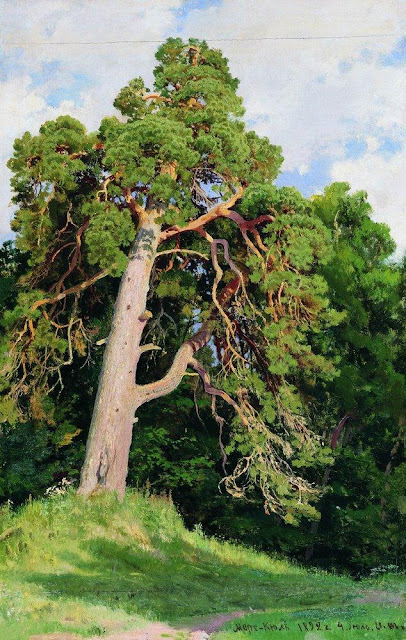Pine, 1892, by Ivan Shishkin
It's an age-old question: Should you as a plein-air painter try to capture exactly what you see, or should you deliberately make changes?
Ivan Shishkin said: "The main thing for a landscape painter is a diligent study of nature. Because of this, the picture from life must be without imagination." John Ruskin said that the student should: “Go to Nature in all singleness of heart, and walk with her laboriously and trustingly, having no other thought but how best to penetrate her meaning, rejecting nothing, selecting nothing, and scorning nothing.”
I don't think Shishkin is really dumping on imagination. Instead of the word "imagination," we might substitute "conventionalism" or "idealization."
I sympathize with what Shishkin and Ruskin are advocating. There is a real joy and challenge for trying to capture exactly what's in front of you without changing or editing or "improving" it. Of course attempting to copy a scene from nature in all its color and detail is not really possible. You have to make choices and simplify something, because you can't capture it all.
Back in the studio, armed with these studies, the artist can assemble the raw material of plein-air studies to create a virtual world of imagination.
I like having a lot of different conceptual approaches ready, like arrows in a quiver, when I head out. Sometimes when I'm on location I want to hold a mirror to nature. But other times I like to exaggerate, elaborate, or invent a fantastical scene while looking at nature.


How do you decide where the horizon line is in this painting? I think that it would change as you go up the tree? Viewing the painting i feel that it is at the top of the shadow in the grass?
ReplyDeleteJames,
ReplyDeleteMy sense is that had Shiskin and Ruskin lived in a time of iphones and digital cameras, they may have felt somewhat differently.
I think doing what ever pleases you is best. I don't like rigid rules very much.
ReplyDeleteHaving read the whole of Stapleton Kearns' painting blog during Covid, I generally now subscribe to his idea that as artists we should modify and improve what we see, rather than merely copy. He really hammers home that idea in regards to composition especially. For me, I still have to remain within the limits of my talents - I can increase or decrease the size of a hill or a tree, but woe to me if I try to change the temperature or color of an object.
ReplyDeleteI also thought of Stapleton Kearns in regard to this. During a workshop with him, he said more than once, "We're out here to be poets, not reporters." Of course, it all comes down to intention and purpose -- sometimes we're trying to capture nature as accurately as possible, other times we're more concerned with the impact of the finished painting.
ReplyDeleteI'll add that artists who faithful reproduce photos hyper-realistically seem to be missing something. To be an artist is not to be a laser printer.
ReplyDelete